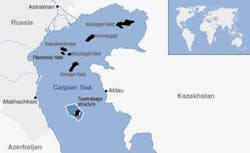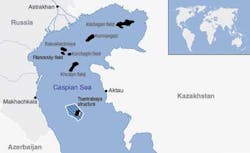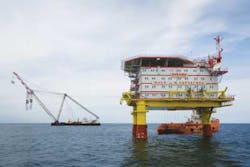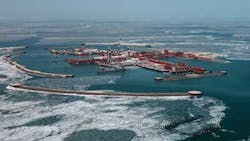Ilya Alkov
Tatiana Yakovleva-Ustinova
Special Correspondents
Over the last few years, the Caspian Sea littoral states, former republics of the Soviet Union, have considerably intensified their work on the Caspian shelf. For some, these resources are the basis of national well-being and help meet their budget needs. For others, Caspian Sea development provides a welcome addition to oil and gas supplies as development of conventional fields becomes more complicated and less fruitful.
The development of the Caspian Sea shelf varies from country to country, with varying levels of successes and difficulty. For instance, Azerbaijan is facing declining recovery rates in its strategic fields of Azeri, Chirag, and Guneshli; investors have left several projects in Kazakhstan; Turkmenistan is contracting works for new blocks; and Russia is intensifying its prospecting and recovery efforts in its own sector. So far, only Russia and Kazakhstan have made sufficiently serious progress in joint development of the shelf at interstate level.
Borders and conventions
It should be mentioned that the Caspian Sea region has long been (and still is) subject to a number of territorial disputes, and a number of these have still not been completely settled. Many of these disputes are related in particular to oil and gas resources.
The process of distributing the fields of activity has been long and complicated, and at present the disputes between the countries have been partially settled by several treaties. In 1998, Russia and Kazakhstan entered into an agreement on the distribution of the northern part of the Caspian Sea, and the protocol to the agreement was signed in 2002. The agreement between Russia and Azerbaijan on the distribution of the adjacent plots of the northern part of the Caspian Sea was entered into in 2002. A trilateral agreement between Russia, Azerbaijan, and Kazakhstan on the junction point of the lines distributing the adjacent plots of the Caspian Sea was signed in 2003. In October 2007, at the summit of the five Caspian littoral states held in Tehran, the Declaration on the future convention of the Caspian status was signed. The convention agreements were expected to be signed in 2014, but this had yet to take place as of press time.
Meanwhile, for all of those years, the Caspian littoral states of the former USSR have been developing their own shelf plots.
Russia
In the Russian sector, the most active developer of the Caspian shelf fields has been the company LUKOIL, with seven fields opened since 1995 (Filanovsky, Korchagin, Rakushechnoye, Sarmatskoye, "170th km," Hazri, and Yuzhnaya) with the total reserves or approximately 1 billion metric tons of equivalent fuel.
LUKOIL launched the Korchagin field into commercial operation in 2010. That is a gas-and-oil-deposit with an oil rim. After supplementary exploration, the estimate of its reserves increased from 30 million to 50 million metric tons of oil and 63.3 billion cubic meters of gas.
Around 2.5 million metric tons of oil and 1 billion cubic meters of gas are expected to be recovered here at the peak per year. An offshore ice-resistant fixed platform with drilling facilities has been erected on the field.
LUKOIL is about to put into operation its second Caspian field named after Filanovsky with reserves of more than 150 million metric tons of oil. This field is the core oil asset of the company in the Caspian Sea. While other fields have huge gas reserves, the oil content of the Filanovsky field is up to 75%.
Initially, LUKOIL was planning to put the Filanovsky field into operation in 2012, but the deadlines were shifted afterwards. The oil company has finished installation of the FPU platform jackets, main underwater oil and gas pipelines, and the inter-field pipelines connecting the Filanovsky and Korchagin fields have been built. The exploitation of the field should start in late 2015/early 2016. 10 million metric tons of oil and 1.4 billion cubic meters of gas per year should be recovered in this field. The investments made in the Filanovsky field development are estimated to cost around $6 billion.
After Filanovsky, the company has turned to the Sarmatskoye field, which is scheduled to placed in operation in 2017. It will be followed by the development of the Rakushechnoye and other fields. By 2020, LUKOIL's annual Caspian oil recovery is expected to be 9.5 million metric tons and gas recovery 9 billion cubic meters.
Russia and Kazakhstan
The Centralnoye field, with extractable reserves of more than 100 million metric tons of oil and 162 billion cubic meters of gas is partially located in the Kazakhstan part of the Caspian Sea.
The field was discovered in 2008. Initially, the exploratory drilling there was performed by a Russian company CentrKaspneftgaz, established by LUKOIL on a par with Gazprom. One well was drilled in the licensed plot. Yet further geological exploration work was suspended due to the expiration of the joint venture geological exploration license. The issuance of a new one has been delayed due to the changes in the Russian legislation that allowed working on the shelf only for companies where the share partially owned by the state exceeded 50%.
In the last few years, Russia and Kazakhstan have started working on an agreement for joint development of the field; and in early 2013 the oil company "Centralnoye" was established with the Kazakhstan company KazmunaiGas as one of the shareholders. The latter got 50% of the company, but Gazprom and LUKOIL received 23% each. This autumn, the Russian government approved the agreement with Kazakhstan on joint development.
Kazakhstan and Russia are also planning to sign one more joint contract on the Caspian; this one for the Hvalinskoe field development. The participants in this project include LUKOIL (50%), KazMunaiGas (25%), Total (18%) and GDF (7%).
Originally, the contract was expected to be signed in 2009, but it was postponed due to several reasons. These included the need to coordinate terms for investors; create a special tax regime and align it with the relevant Russian legislation, and then harmonize the hydrocarbon export schemes. The project continues to be stalled, and it seems that the agreement will not be signed this year.
Nevertheless, a breakthrough was experienced in another joint project, Evraziya, which involved drilling an ultra-deep well (15 km) in the Caspian Trench area. In early October, the presidents of Russia and Kazakhstan – Vladimir Putin and Nursultan Nazarbayev – gave the starting signal to this new joint project. The parties hope to discover new hydrocarbon reserves in that area. The initial project investments will account for $500 million, and a consortium is planned to be established for carrying out the project work. Potential participants include LUKOIL, Rosneft, Shell, Chevron and others.
Kazakhstan
The strategy of Kazakhstan presupposes considerable growth in hydrocarbon extraction, according to the data of the Association Kazenergy. According to these estimates, by 2020 the country will increase the recovery of oil with gas condensate volumes from the current 80 million metric tons to130 million metric tons. A considerable part of the volume must be ensured by the Caspian Shelf development.
At present, the main marine project of Kazakhstan is the Kashagan field in the Northern Caspian that was discovered in the early 1990s. The first well here was drilled in 2000. Geological oil reserves in the field account for 4.5 billion metric tons (35 billion barrels), out of which some 1.7 billion metric tons are expected to be recovered. Natural gas reserves are estimated to be more than 1 trillion cubic meters.
At present, the project shareholders are KazMunaiGas, Eni, Shell, Exxon Mobil, and Total, owning equal shares of 16.81% each, and 7.55% of the project belongs to the Japanese company INPEX; but from September 2013, the Chinese company CNPC has acquired 8.3% of the project.
The Italian Agip Kazakhstan North Caspian Operating Co. (Agip KCO), subsidiary company of the Concern Eni, was initially assigned the function of the operator. In January 2009, it was replaced by NCOC (North Caspian Operating Company). Agip KCO remained in charge of Phase 1 implementation of the Kashagan field development (pilot-commercial production), as well as of the on-land part of Phase 2.
The project participants forecasted that in the first stage, during first four years after starting oil recovery, the recovery volume would reach 50 million metric tons; and in the second stage, two to three years later, it would be 75 million metric tons. That should have placed the country among the top five oil exporting countries in the world.
However, the project geology and climatic conditions at the Kashagan field are particularly complicated. To facilitate the development in the contract area, four artificial islands interconnected by pipelines among themselves and with the shore were built.
Yet the advanced technological solutions applied could not prevent regular postponing of the start of the field exploitation from the initial term (year 2005). As a result, the start date for commercial production was set to the end of 2012. Nevertheless, that deadline was not met either. Production actually started in late 2013, yet it was suspended due to a gas leak two weeks later.
The analysis showed the presence of many microcracks in the pipeline, caused as a result of the metal exposure to high sulphur content associated gas.
In the middle of 2014, Kazakhstan representatives repeatedly reported that the oil recovery in the field could not be started before the first half of 2016, although experts question that deadline. Meanwhile, the project participants have made the decision on selecting a new project operator to replace the NCOC.
With the delay of the Kashagan project, Kazakhstan oil recovery forecasts for 2014 have declined. According to KazMunaiGas data, this indicator will decrease from 83 million metric tons to 81.8 million metric tons.
Azerbaijan
The biggest oil sector project of Azerbaijan is the development of offshore fields Azeri, Chirag, and the deepwater part of Guneshli. The contract on development, called "the Contract of the Century" was signed on Sept. 20, 1994.
Oil recovery in the Chigar field started in November 1997, in the central part of Azeri; from February 2005, in the western part of Azeri; from December 2005, in the eastern part of Azeri; from October 2006; and in the deepwater part of Guneshli, from April 2008.
It was expected that the block increase from the initial 540 million metric tons to 940 million metric tons would ensure stable recovery growth over several years, reaching 50 million metric tons per year by 2012. However, difficulties emerged in the production rates. In 2011, instead of an increase in the daily average production to 830,000 barrels, the indicators dropped to 757,000 barrels; and in 2012, the indicator dropped to 664,000 barrels.
According to the expert opinion, the light crude oil recovery process at ACG ended sooner than expected; now the recovery is getting more complicated in terms of technology. In February 2013, BP-Azerbaijan announced that drilling new wells and taking other measures were planned for the purpose of stabilizing the recovery.
Meanwhile, in September 2014, SOCAR announced that 345 million metric tons of oil and 100 billion cubic meters of gas had been recovered from the start of the ACG block development. In 2013, 32.2 million metric tons of oil were recovered from the ACG block, compared to 32.9 million metric tons in 2012.
The biggest gas project in Azerbaijan is Shah-Deniz. The project envisages delivery of the Azerbaijanian gas to Europe and Turkey. The Shah-Deniz field reserves are estimated at 1.2 trillion cubic meters of gas. Located in the southern part of the Caspian Sea, 70 km to the south-west from Baku, the hydrocarbon structure Shah-Deniz was opened in 1954.
The contract on the field was signed on June 4, 1996, in Baku. The company BP (project operator, 25.5%), Statoil (25.5%), GNKAR (10%), LUKOIL (10%), NIOC (10%), Total (10%), and TPAO (9%) became the project participants.
In 1999, the first well was drilled in the contract plot. The open gas-condensate field reserve estimate accounted for 1 trillion metric tons of equivalent fuel. In 2001, four natural gas sales-purchase contracts were entered into with the Turkish company BOTAS, the Azerbaijan government, and two agreements with Georgia. These contracts allowed the Shah-Deniz project participants to approve Stage 1 of the project in February 2003.
Recovery of 178 billion cubic meters of gas and 34 million metric tons of gas condensate per year was planned within the framework of the Stage 1. For the purpose of transporting the gas from Shah-Deniz to Turkey, the South Caucasus Pipeline was built in 2005-2006.
In December 2006, the first gas from the Shah-Deniz field was obtained, and in July 2007 the gas reached the territory of Turkey. Some 51 billion cubic meters of gas and 13.3 million metric tons of gas condensate have been recovered at Shah-Deniz from the beginning of its development.
Within the framework of Shah-Deniz-2, on which the final investment decision was taken in December 2013, the production is planned to increase to 25 billion cubic meters per year. Within the framework of the project, 16 billion cubic meters of gas per year are planned to be supplied within 25 years to the European market via the Trans Anatolian Natural Gas Pipeline (TANAP) and the Trans Adriatic Pipeline (TAP). The gas supply to Turkey is expected to begin in 2018, and to Europe in 2019.
In May 2014, Statoil sold a 10% share of its 25.5% holding in the projects Shah-Deniz and the South Caucasus Pipeline to BP and Azerbaijan's GNKAR. Statoil sold another 15.5% share to Malaysia's Petronas in May, thus completely dropping out of the project. The company announced that it had made that decision due to its cost-optimization. After the transactions the share participation was distributed in the following way: BP (28.8%), Iranian NICO (10%), LUKOIL (10%), Turkish TPAO (9%), and SOCAR (16.7%).
Turkmenistan
The Caspian Shelf resources of Turkmenistan account for approximately 12 billion metric tons of oil and 6 trillion cubic meters of gas. Those are the data from the State Agency for the Management and Use of Hydrocarbon Resources under the President of Turkmenistan, published in the 2Q 2014. The Caspian sector is divided into 32 licensed blocks that might be the subject of negotiations with potential investors.
The biggest investor in the Caspian projects of Turkmenistan is the Malaysian company Petronas, which has been operating on the shelf since 1996. At the same time, the main offshore oil production amount is ensured by Dragon Oil (UK-ARE), which recovered 3.4 million metric tons in 2013, by 10% exceeding the volume recovered in 2012. It should be pointed out that the development of a range of offshore fields is complicated due to mutual territorial claims between Turkmenistan and Azerbaijan.
Two big fields, Jeitun and Jigalbek, are situated in Cheleken, the main block of the Caspian Shelf of Turkmenistan. The development is run by Dragon Oil via its subsidiary structure Dragon Oil Turkmenistan Ltd. on the basis of the production-sharing agreement signed in 1999 for a 25-year period. The potential oil and gas condensate reserves at Cheleken are estimated at 677 MMbbl, and natural gas at around 1.5 tcf. According to the data as of the end of 2013, the oil production in the field exceeded 73,000 b/d, and this indicator should grow to 100,000 b/d by 2015.
The authors
Ilya Alkov is Markets Editor with Oil & Gas Journal Russia. He graduated from the Moscow State Pedagogical University (Faculty of History) in 1995, and from 1995-1998 he worked for the Interfax news agency as reporter and editor in the oil and gas division. In 1998, he graduated from the educational program "International Oil and Gas Business" at the MGIMO University, and went on to work for various oil and gas and business periodicals and websites as an observer and editor, and for conference companies as a producer. In 2011 he joined Oil & Gas Journal Russia as markets editor.
Tatiana Yakovleva-Ustinova is an observer with Oil & Gas Journal Russia. She graduated from Moscow State University (Faculty of Journalism) in 1990, and from 2003-2013 worked for various oil and gas magazines. In 2013, she joined Oil & Gas Journal Russia as an observer.






